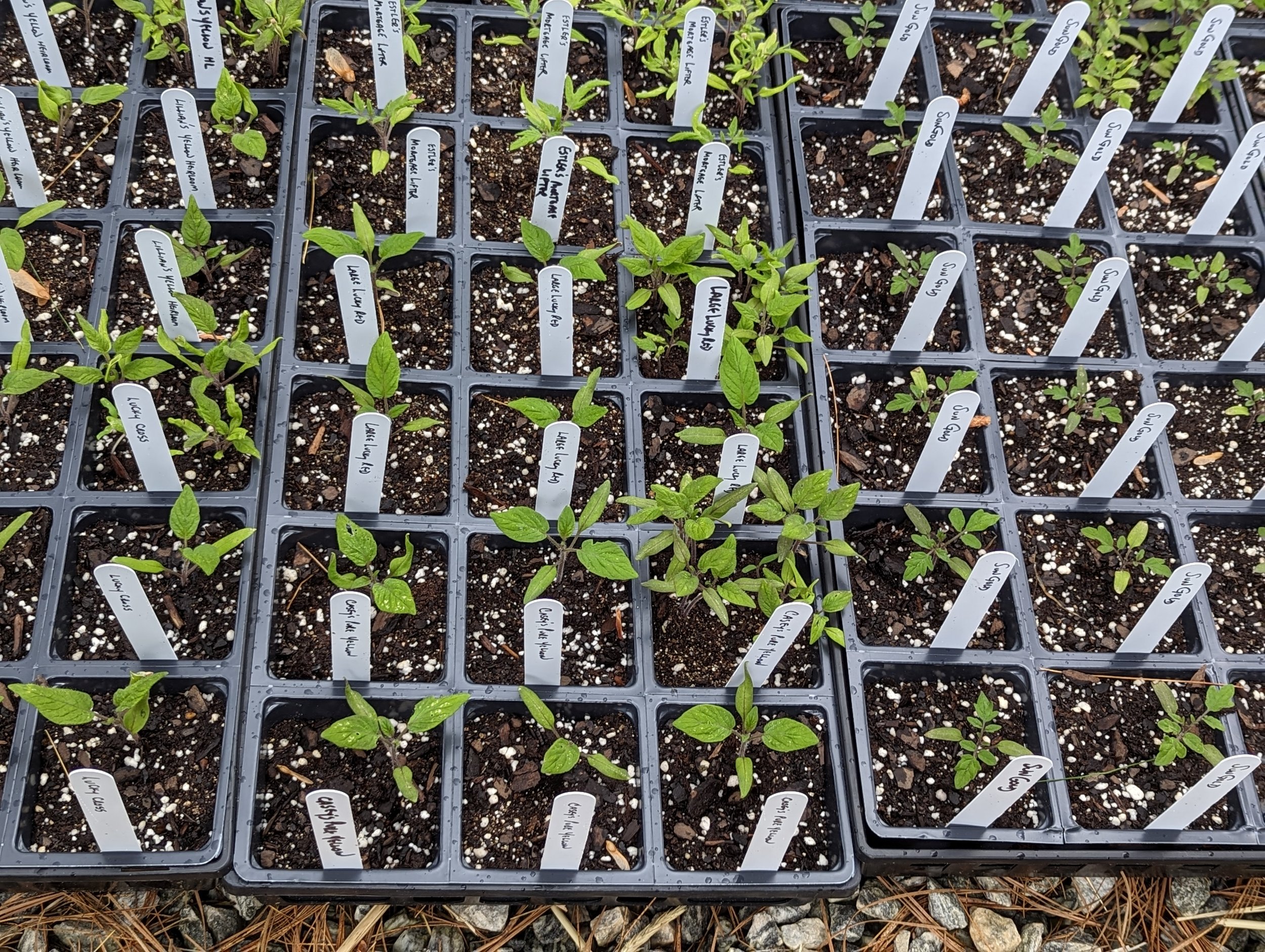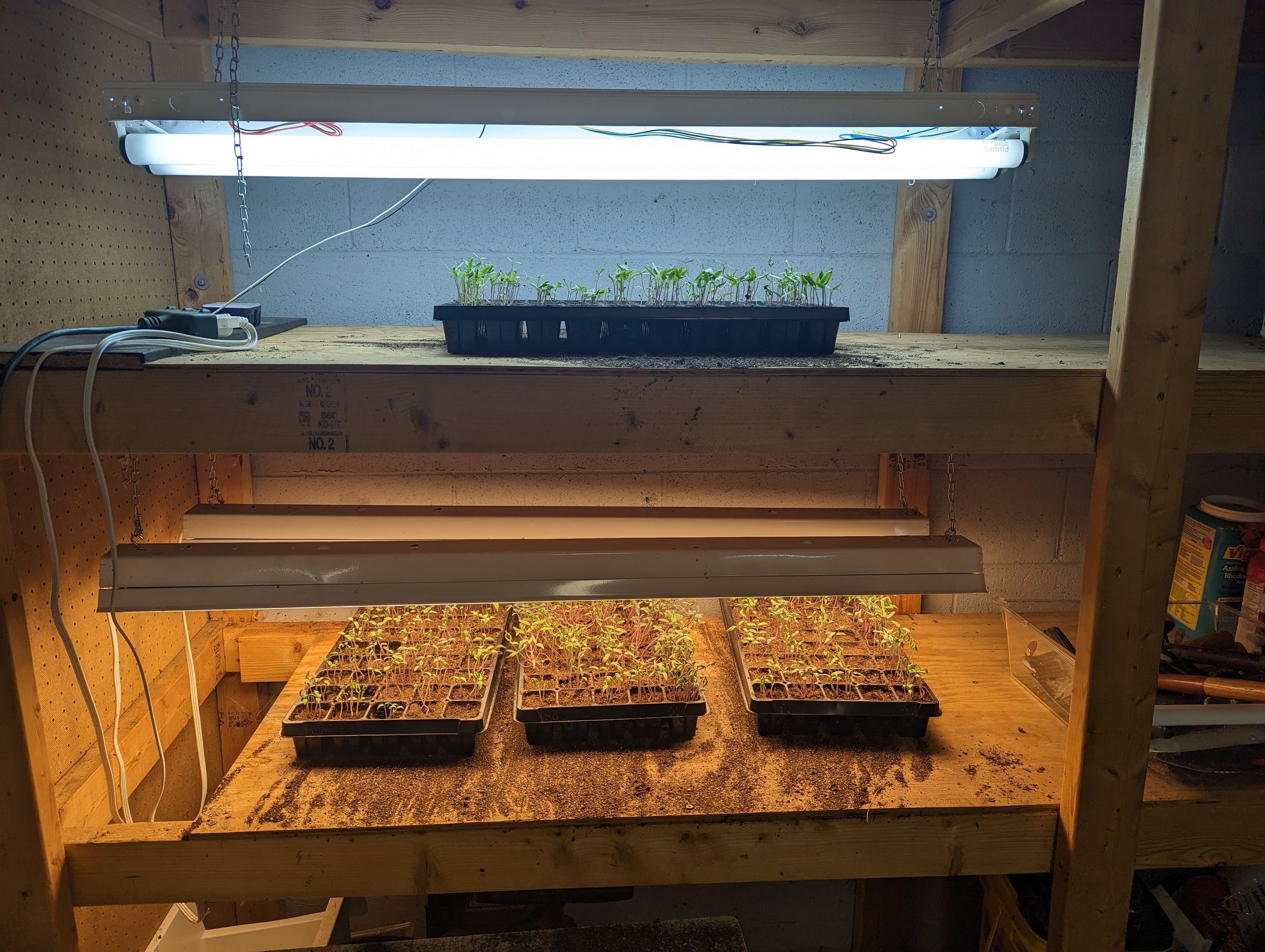July 25 shot of the melon bale - things were looking good on this date, at least
2023 saw a bit of a reorganization of the back yard straw bale garden. The last three years had the cukes, squash and beans to the left of the main tomato area. Shading at times of the day by the pine trees bordering our yard wasn’t optimal for these heat loving crops, so this year they were located to the right of the tomatoes. This seemed to work much better, and led to mostly success, with a few notable failures.
April 1 - this shows the garden layout for 2023. Front right is the quartet of bales for beans - one bale for melons sits behind. To the left is the quartet of bales for squash, with cukes behind.
This update will cover my results for the following crops - summer squash, cucumbers, melons, snap beans, peppers, eggplants, herbs, greens, garlic and potatoes.
Summer Squash - I chose 4 varieties; Eight Ball hybrid (a round dark green zucchini), Sunburst hybrid (bright yellow patty pan with a dark green “button”), Benning’s Green Tint (pale green maturing to white heirloom patty pan), and Zephyr hybrid (yellow summer squash with a pale green blossom end). The first three were new to us. I places a 3 inch deep area of potting mix onto the prepared bales and planted 3 seeds of each type. After the seeds germinated and the true leaves emerged, I removed one plant from each hill - this resulted in 8 squash plants, 2 of each type. They grew quickly and well, with the Benning’s Green Tint clearly the weaker growing of the four varieties. Flowering commenced, then fruit set. All of a sudden we went from eagerly awaiting harvest to a state of overwhelm. 8 summer squash plants for two people is simply too many plants. We enjoyed all four varieties, but struggled harvesting them when at perfect eating stage (quite small). The larger 8 ball were used to grate for chocolate zucchini bread. The patty pan and round types were typically cut into slabs and either grilled, or dipped in egg, then bread crumbs, then baked. The best variety for steaming by far was Zephyr - it is just delicious and has a nice firm texture. Overall, we rated Eight Ball and Zephyr the best for our particular needs, followed by Sunburst (a very good squash), with Benning’s Green Tint coming in last. Benning’s was relatively disappointing in yield compared to the other three, which were squash machines.
As far as plant health, only a few squash bugs showed up, which were quickly squished. Mildew was not a problem until mid August, when we were getting tired of eating them. The plants were not attacked by squash vine borer.
Next year we will likely go with one bale and 2 plants - returning to Dunja hybrid zucchini, and staying with Zephyr. It’s time to regain sanity and not overplant the summer squash.
Basket of summer squash (all four types represented), along with cucumbers, from early July.
Cucumbers - Once again, it was all about the hybrid Unagi. I dedicated one straw bale and planted two hills, 3 seeds each. The vines grew well, filled the tomato cages that I inserted onto the bales. The result was a nice yield of tasty cukes. We noted quite a few cucumber beetles - both the spotted and striped versions - so knew that the days of healthy vines were numbered. Eventually they died from likely viral disease spread by the pests. It was fine, as we had plenty. I still like the flavor of Diva a tiny bit more, but the Unagi were fine and likely lasted a bit longer before plant death.
A midsummer harvest of Marbel, Goldilocks and Celine snap beans
Snap Beans - These were definitely a highlight of the 2023 garden. Into a pushed-together quartet of straw bales covered with a thick layer of potting mix were direct seeded, double rows of Marbel, Goldilocks and Celine beans. Marbel is a long time favorite and a bean I brought back from obscurity a few years ago. It is a filet bean that is picked young, long and slender - it has distinct purple stripes that vanish upon cooking. when picked very slender they are stringless, with a lovely texture and rich flavor. Goldilocks is a bright yellow wax filet bean that was the best of the three in terms of yield and flavor. Celine is quite new and unique - it is the first dark purple wax bean, having yellow flesh. When cooked the purple color fades to a dusky wax bean color. The yield is not quite as heavy as Goldilocks, and the bean size not as long. Despite the odd cooked color, the flavor is delicious. I highly recommend all three (though Marbel is not yet available in seed catalogs). If all goes well, Victory Seeds will remedy that in a year or so. There are other snap bean types I enjoy that I will return to in the future - Maxibel, Fowler, Jade, and Roc d’Or in particular. I was going to pull the plants and plant a second crop, but the first planting gave us all we needed.
Melons - I prepared one strawbale for melons (it has been years since growing them - and I’ve not grown them successfully since early on in my Raleigh dirt garden). After bale prep, I added a thick layer of potting mix and direct seeded three types - Minnesota Midget, Eden Gem, and a hybrid from Johnny’s called Lambkin. I inserted two wire tomato cages over the hills. The melons germinated well and filled the cages, and also set fruit well. Alas, by the time the melons were sizing up and approaching ripening, disease hit - likely viral, spread by the spotted and/or striped cucumber beetles. The melon growing experience failed, and I will likely not repeat it.
Potatoes - my garden friend Bill Minkey sent me a few samples of five different potatoes - Romanze, French Fingerling, Magic Molly, Peruvian Purple and Chris Blue. All were planted in 20 gallon plastic containers in spent straw from last year’s strawbales. Bill gave me sufficient material to plant four pieces of each. The vines grew vigorously and well, finally starting to die back a few weeks ago. I ended up with a decent harvest of each, with French Fingerling the best producer by far, and Peruvian Purple giving the lowest yield. They were fun to grow, did well, but I can’t say that the flavor is any better than store bought Yukon Gold, so this was probably my only - and last - try at growing potatoes.
Lettuce in our raised beds
Greens - This was not a major effort this year, but went typically well. For lettuce, I focused on a few varieties that we really enjoy - Cherokee, Magenta (both red Batavia types), and Green Ice. Seeds were started early indoors and seedlings moved into our raised beds. We harvested plenty for our salads until they bolted from the increasing heat. I also grew a mustard, a kale and a collard - the mustard bolted quite quickly, but we enjoyed a nice harvest from the collard and kale - they shared our larger raised bed with the lettuce. I also started some rainbow chard - it is in the same bed and still going strong. If I can get sufficiently motivated I will get some lettuce seeded for fall into early winter growing.
Turmeric - When working in the greenhouse at the Veterans Healing farm, I noted that some of last year’s turmeric was emerging around some of the tomato plants. I dug a piece of the root and brought it home to plant in our elevated raised bed. It is growing well - at some point I will carefully dig the root to see how it is doing, and perhaps pot some up and keep in the garage this winter, for plant out next spring.
Ginger - With turmeric up and growing I got the idea to plant some ginger (a first for me). I purchased a nice fresh piece at the grocery store and broke it into several pieces, which were planted in potting mix in clay pots. It took a month or so, but small green growth emerged from each piece. These were moved into the raised bed after removal of the lettuce and other greens. It is growing well in three areas, and is nearing a foot tall. At some point I will dig the pieces, break some off to cook with, and pot up the rest for keeping in the garage over the winter.
Garlic - I planted approximately 20 cloves of garlic from the prior season in September, 2022, at the back of the raised bed. It grew well and by June of this year started to look ready to harvest (lower leaves yellowing), just after scaping (which we harvested - delicious to cook with). Each clove produced nice firm bulbs of varying sizes - these were dug, gathered into two bunches, tied with twine and hung in the garage to try. We are just starting to use it in our cooking. I will plant some of the cloves in a few weeks in the raised bed. This is an easy and satisfying crop to grow.
Basil - I started four types of basil from seed - Genovese, Devotion, Prospera (the latter two newer varieties bred for resistance to downy mildew), and a dark purple variety called Caramel Chianti. All germinated well - we grew several plants of each in our raised beds, as well as a few containers. The Genovese became afflicted with what appeared to be Fusarium. All of the others continue to do fine. We have a lot of frozen pesto from last year, so didn’t need to process any this year. My Greek Columnar rooted cuttings from last year didn’t survive the winter, and I couldn’t locate a seedling to grow this year.
Peppers and eggplants, early September
Peppers - Three straw bales and a few grow bags supported our reduced pepper efforts this year. I focused on the varieties I am developing from Islander hybrid - White Gold, Carolina Amethyst, Fire Opal, and Royal Purple - as well as Shishito, Chocolate Bell, Orange Bell and a Jalapeno given to me by a gardening friend.
It was another challenging year for peppers - a few of the varieties were plagued by insects chewing holes in the leaves, as well as slugs. All varieties caught on well, but the sweet bells tend to rot prior to turning ripe colors. Cooler late summer weather alleviated this issue somewhat. Carolina Amethyst grew out as the same color as Fire Opal, so more work is needed. The Shishito yielded heavily and is trouble free, still thriving. Alas, the Jalapeno must have been one of the defanged selections - it has no heat at all!
Eggplants - Strawbales and growbags hold the small selection of eggplants, all from my selection work - Midnight Lightning, Twilight Lightning, Skinny Twilight and Mardi Gras. They did - and continue to do - very well. They present less problems for me than bell peppers.
Next up will be the first of the 2023 tomato summaries. There will be several of them - there is a LOT of info to gather and present.
late August view of the flower garden






























